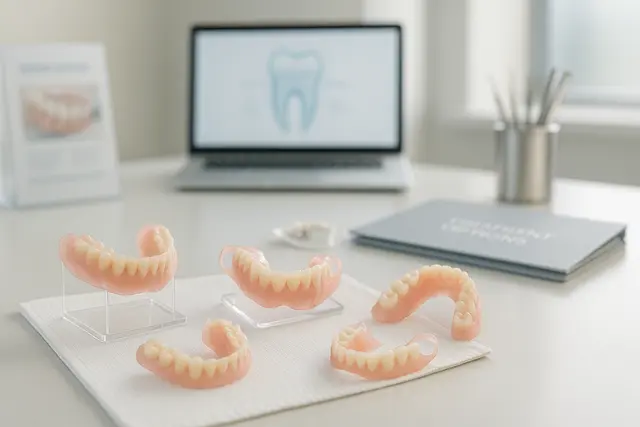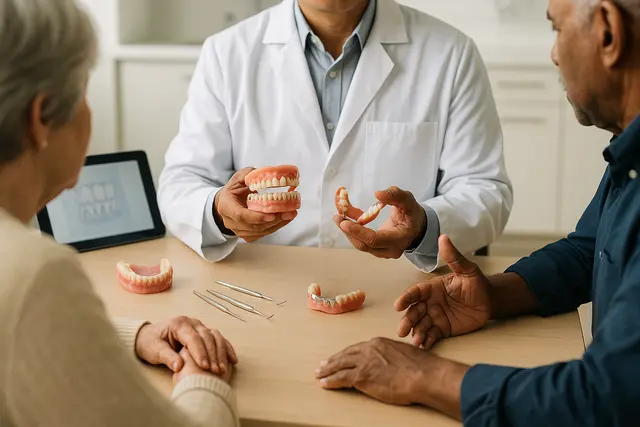Prosthodontics
6 min read
Nov 02, 2025
Flexible Denture Options for Patients: What to Expect and How They Work
Missing teeth can affect more than just your appearance, they can impact your confidence, comfort, and ability to enjoy everyday activities. Fortunately, modern dentistry offers a variety of solutions, including flexible dentures that provide a more comfortable and natural-looking alternative to traditional options.

If you're missing one or several teeth, you're not alone, and you're not without options. Thanks to modern advancements, patients now have more choices than ever when it comes to dentures, especially flexible denture solutions that blend comfort, aesthetics, and practicality. Whether you've struggled with rigid acrylic in the past or you're exploring your first partial denture, understanding how flexible dentures work can help you make the right decision for your smile and daily life.
How a Denture Can Improve Your Smile and Confidence
A denture is a custom-made dental prosthetic designed to replace missing teeth. Dentures come in many shapes and sizes, depending on how many natural teeth you still have and the condition of your gums and jaw. While traditional dentures have been around for decades, newer flexible options have become increasingly popular, especially for people who want a more comfortable and discreet way to restore their smile.
Dentures are often used to improve not just the appearance of the smile but also your ability to chew, speak, and enjoy social interactions without feeling self-conscious. Plus, a properly fitted denture helps prevent facial sagging and further oral health issues.
What Makes a Flexible Denture Different from Traditional Dentures
Unlike traditional dentures made with rigid acrylic or metal, a flexible denture is crafted from a flexible thermoplastic material that bends and adapts to the natural contours of your mouth. This flexibility offers a much gentler feel, especially for patients who’ve experienced irritation and sore spots with stiffer options.
Flexible dentures are another level of comfort because they don’t rely on metal clasps or bulky acrylic frameworks. Many patients find the flexible nature of these dentures makes them feel more natural, lightweight, and far less invasive in everyday use.
Partial Denture Options and When They Make Sense
If you still have some natural teeth left, a partial denture might be recommended instead of a full denture. Partial dentures are removable appliances that fill in the gaps created by one or more missing teeth, helping restore both function and appearance.
Traditional partial dentures are made with metal frameworks and rigid acrylic bases, which can sometimes cause discomfort or difficulty adjusting. On the other hand, a flexible partial denture is designed to be much softer, adapting better to the mouth’s movement without sacrificing durability.
Patients who want a more seamless transition into wearing a denture, without the awkward adjustment phase, often benefit from flexible partial dentures.
Why a Flexible Partial Can Be a Game Changer
A flexible partial works especially well for people who need to replace teeth in the upper or lower arch but aren’t ready for implants or full dentures. The flexible thermoplastic base grips the gums gently without harsh edges, and the clasps, if needed, are made from the same flexible material used in the denture base, giving a more discreet appearance than metal clasps.
Flexible partial dentures are also less likely to crack or break when dropped compared to rigid acrylic ones. That alone makes them a safer and more cost-effective option for many patients.
Flexible partial dentures are removable, so you can take them out at night or for cleaning, which helps with overall dental care and hygiene.
The Dental Materials That Make Flexible Dentures Unique
What makes flexible dentures so adaptable is the thermoplastic material used in their construction. Brands like Duraflex and Valplast have led the way in developing high-quality resin materials that offer strength, flexibility, and aesthetics.
Duraflex dentures tend to feel slightly more firm but offer excellent durability. Valplast dentures are known for their ultra-flexible and lightweight feel, making them ideal for patients with sensitive gums or smaller dental arches.
So when patients ask about the differences in duraflex vs valplast, the choice often comes down to comfort preference and dentist recommendation. Both are made from flexible thermoplastic material and offer a far superior fit compared to rigid dentures.
Exploring the Best Flexible Partial Denture for Your Needs
Choosing the best flexible partial denture isn't a one-size-fits-all decision. Your dentist will evaluate several factors like the number of missing teeth, your gum health, and your bite alignment before recommending a specific type of flexible denture.
In some cases, the best flexible partial denture might involve combining flexible thermoplastic with traditional components to create a custom solution that balances strength and comfort. The right flexible partial could also depend on whether you're replacing front teeth (where appearance matters most) or back teeth (where function is key).
Benefits of Flexible Dentures That Patients Love
Here’s why many patients benefit from flexible dentures:
Comfort: The soft, lightweight material reduces sore spots and adapts well to mouth movement.
Aesthetics: They blend naturally with your gum color, making them virtually invisible.
Durability: Flexible dentures are less likely to break or crack compared to acrylic dentures.
Adaptability: They’re ideal for patients with allergies to acrylic or metal partial dentures.
Flexible dentures offer a comfortable and appealing solution, especially for patients who’ve struggled with traditional options in the past.
Types of Flexible Denture Options You Might Consider
There are several types of flexible dentures depending on your needs. Some common options include:
Flexible partial dentures for one or several teeth
Full flexible dentures for patients with extensive tooth loss
Duraflex dentures for added firmness
Valplast dentures for maximum flexibility
Each type of flexible denture has its strengths, and the one you choose will depend on comfort, aesthetics, and your dentist's advice.
The Cost of Flexible Dentures and What to Expect
Now, let’s talk numbers. The cost of flexible dentures can vary depending on how many teeth you need to replace, the denture material used, and whether additional work (like extractions or adjustments) is needed.
While flexible dentures may cost a bit more than traditional ones, many patients say the investment is worth it for the comfort, aesthetics, and reduced need for follow-up repairs. Ask your dentist about payment plans or insurance options that may help manage the expense.
Understanding the Disadvantages of Flexible Partial Dentures
While flexible dentures come with many benefits, they’re not perfect for everyone. Some disadvantages of flexible partial dentures include:
Less rigid: May not provide the same bite force as acrylic or implant options.
Cleaning requirements: The flexible resin material can hold onto bacteria if not cleaned properly.
Not ideal for all situations: Patients with extensive tooth loss may require a more supportive solution.
Still, for many, the advantages outweigh the drawbacks, especially for short to medium-term use.
Dentures Come in All Styles
Dentures include a wide variety of styles, materials, and configurations. Dentures are removable dental prosthetics, and while they serve the same core purpose, replacing teeth, they're definitely not one-size-fits-all.
The right flexible partial denture will depend on how many natural teeth you have left, your lifestyle, and your personal comfort preferences. Your dentist will guide you in how to choose the best option for your situation.
From Implant Alternatives to Full Denture Solutions
Not ready for a dental implant? That’s okay. Implants are excellent, but they’re not the only high-quality solution out there. A flexible denture can be a great alternative, especially for those who want something less invasive and more affordable.
For patients with extensive tooth loss, a full denture made from flexible thermoplastic can provide a secure fit without the bulk and discomfort of rigid dentures.
What Are Flexible Dentures and How Do They Work?
Flexible dentures are lightweight, removable dental prosthetics made from soft thermoplastic materials that adapt to the natural shape of your gums. Unlike traditional acrylic or metal-based dentures, they bend slightly as you move your mouth. This flexibility provides a more comfortable fit, reduces gum irritation, and offers a secure, natural-feeling way to replace missing teeth. They are especially useful for patients who need a partial replacement and prefer a gentler, more aesthetic option.
How Are Flexible Partial Dentures Different From Traditional Dentures?
Traditional dentures rely on rigid acrylic or metal frameworks and can sometimes feel bulky or irritate the gums. Flexible partial dentures, however, use a softer, more adaptable resin that blends with your gum color and eliminates the need for metal clasps. This results in a more discreet look and a more comfortable fit. While both serve the purpose of replacing missing teeth, flexible options prioritize comfort, aesthetics, and easier adaptation for new denture wearers.
Who Is a Good Candidate for Flexible Partial Dentures?
Flexible partial dentures are ideal for patients who are missing one or several teeth but still have strong remaining natural teeth to support a partial design. They work well for individuals who may be sensitive to rigid dentures, those with acrylic or metal allergies, or anyone wanting a lightweight, natural-looking tooth replacement. However, they may not be suitable for patients with extensive tooth loss or those who need significant structural support, those situations may require full dentures or implant-based options.
How Do I Care for Flexible Dentures to Keep Them in Good Condition?
To keep flexible dentures clean and long-lasting, daily care is essential. Remove and rinse them after meals, brush them gently with a soft brush, and clean your gums and remaining teeth thoroughly. Soaking them in a denture-safe cleaning solution helps prevent bacteria buildup and staining. Regular dental checkups are important to monitor fit and oral health, as flexible materials can collect plaque if not cleaned properly. With consistent care, flexible dentures can stay comfortable and attractive for years.
Read Next
Related Posts

Prosthodontics
Differences Between Zirconia and Acrylic Dentures: Benefits, Drawbacks, and Tips
Choosing between zirconia and acrylic for dental implants can feel overwhelming, especially when both materials offer unique advantages. This guide breaks down the essential differences, benefits, and limitations of each option to help you make a more confident, informed decision about your dental restoration journey.
5 min read
Nov 03, 2025

Prosthodontics
Dentures vs. Partial Dentures Pros and Cons: Helping You Make the Best Choice
Tooth loss can impact everything from your self-confidence to your ability to enjoy your favorite foods. Fortunately, modern dentistry offers practical solutions that restore both function and aesthetics. Two of the most common options are full dentures and partial dentures, each with its own advantages and limitations.
5 min read
Nov 03, 2025

Prosthodontics
Partial Dentures vs. Full Dentures Comparison: What Works Best for Your Situation
Choosing between partial and full dentures is an important step in restoring both your smile and confidence. With each option designed to meet different dental needs, understanding their differences can help you make the right decision for your oral health and lifestyle.
5 min read
Nov 03, 2025
Don’t have time to research every dentist around you?
See why 30k+ patients trusted us